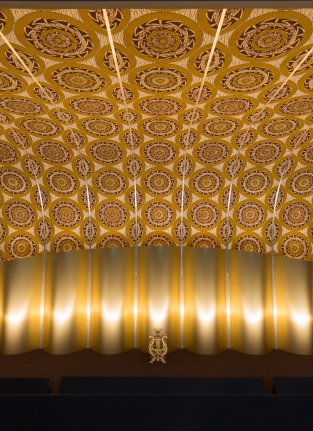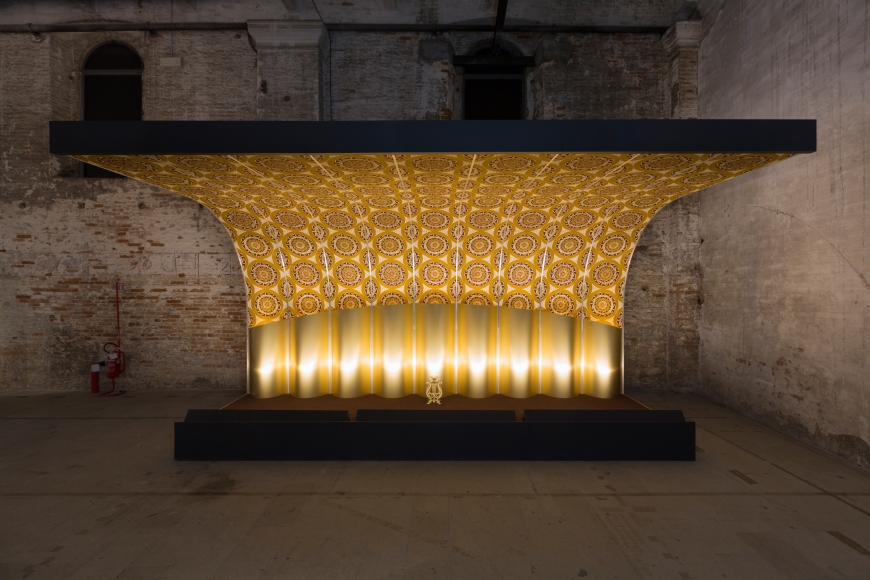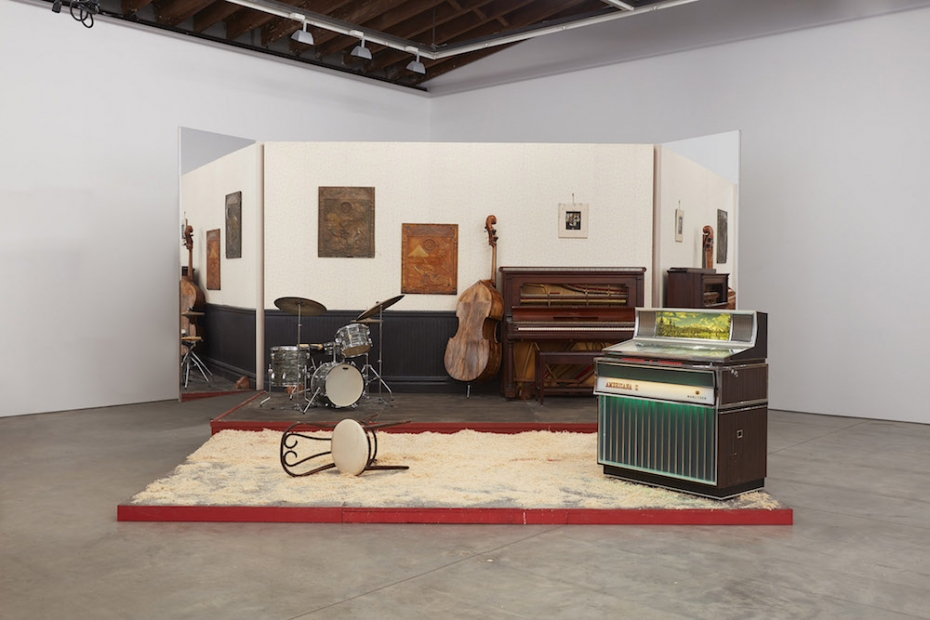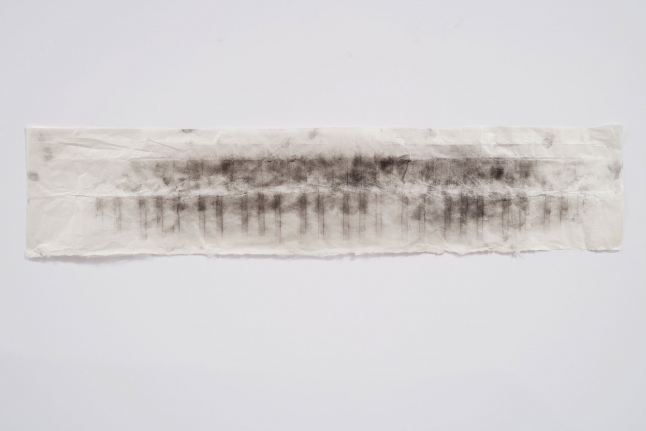
Jason Moran
The first solo museum show of Jason Moran (b. 1975, Houston, Texas), the interdisciplinary artist who grounds his work in music composition, will make its New York debut at the Whitney this September.
Staged. Three Deuces, 2015
About the exhibition
Jason Moran, which originated at the Walker Art Center in Minneapolis in the spring of 2018, presents the range of art Moran has explored, from his own sculptures and drawings to collaborations with visual artists to performance and video. An immersive installation will fill the Whitney’s eighth floor galleries from September 20, 2019 through January 5, 2020. The exhibition will be activated by in-gallery musical performances by the artist himself and by other musicians throughout the run of the show. Two marquee events unique to the Whitney’s presentation will include the New York premiere of Kara Walker’s Katastwóf Karavan (2018), a steam-powered calliope housed in a parade wagon, and a special twentieth anniversary concert for Moran’s trio, The Bandwagon. (Complete details on the performance series will be announced in August.) Jason Moran is overseen at the Whitney by Adrienne Edwards, the Engell Speyer Family Curator and Curator of Performance, who originated the show at the Walker.
A renowned musician and composer known for jazz styles from stride piano to free improvisation, Jason Moran’s experimental approach to artmaking aligns objects with sound in an effort to underscore their inherent theatricality. Whether executed through the medium of sculpture, drawing, or sound, his works bridge the visual and performing arts. In all aspects, Moran’s creative process is informed by one of the essential tenets of jazz music: the “set,” in which musicians come together to engage in a collaborative process of improvisation, riffing off of one another to create the musical experience.

Staged. Savoy Room (detail), 2015
“Jason Moran is one of the most vital and boundary-breaking creative voices of our time, and his wide-ranging collaborations with other visual and performing artists have had a profoundly generative effect on their work as well as on his own artistic development,” remarked Scott Rothkopf, the Whitney’s Senior Deputy Director and Nancy and Steve Crown Family Chief Curator. “This exhibition extends the Whitney’s long and vibrant history of presenting artists who traverse the boundaries of the visual and performing arts and brings together so many artists who are dear to the Museum. We’re thrilled the show marks Adrienne Edwards’s curatorial debut in our galleries and also Jason’s return to the Whitney, following his appearances in Glenn Ligon: AMERICA in 2011 and our Biennial the following year.”
“It is heartening to have the national tour of Jason’s exhibition culminate in New York City, where he and so many of his collaborators live and make their work. New York is where jazz has evolved, and the venues that fostered it are referenced directly in the major sculptures that serve as stages within the show,” noted Edwards. “Presenting the exhibition at the Whitney makes for a double ‘homecoming,’ since Jason and his collaborators have long-standing histories with the Museum, having exhibited here or featuring in our collection. Taking its cue from Jason’s art and that of his collaborators, this show questions the boundaries between artistic disciplines and how they are presented. It is a solo show that is also a group show; it takes place in neither a white cube nor a black box theater or nightclub, but rather in an in-between space that is some combination of them all. It is a survey exhibition, yet holds together like a singular art installation—at times a visual art show and at other times a performance venue.”
Jason Moran, which originated at the Walker Art Center in Minneapolis in the spring of 2018, and has traveled nationally to the Institute of Contemporary Art in Boston and the Wexner Center for the Arts, considers the artist’s solo and collaborative works as generative investigations that further the fields of experimental jazz, performance, and visual art. Shown together for the first time in this exhibition, Moran’s mixed-media “set” installations STAGED: Savoy Ballroom 1 (2015), STAGED: Three Deuces (2015), and STAGED: Slugs’ Saloon (2018) pay homage to iconic jazz venues of New York’s past. Collaboration has been central to Moran’s experiments, and among the many artists with whom he has collaborated are Stan Douglas, Lizzie Fitch and Ryan Trecartin, Theaster Gates, Joan Jonas, Glenn Ligon, Julie Mehretu, Adam Pendleton, Lorna Simpson, and Carrie Mae Weems. These collaborative works are exhibited here, many in a synchronized loop arranged by Moran on projection screens. Moran’s original musical scores and a recent selection of his charcoal drawings from the ongoing Run series, which give sculptural presence to sound, are also featured in the exhibition.

Staged, Savoy Ballroom, 2015
STAGED
Sculptural vignettes based on storied New York City music venues, Moran’s STAGED works reimagine the architecture of these cultural landmarks and double as concert stages. STAGED: Savoy Ballroom 1 and STAGED: Three Deuces were part of Moran’s contributions to the 2015 Venice Biennale international exhibition All the World’s Future, curated by Okwui Enwezor. The latest sculpture from the series, STAGED: Slugs’ Saloon (2018), was commissioned for this exhibition by the Walker Art Center. Each is integrally connected to the social history and real politics of the venues for which they are named—important sites of invention and innovation in jazz that were also testing grounds of American policies of nondiscrimination at the height of the Jim Crow period of segregation.

Staged, Slugs Saloon, 2018
The legendary Savoy Ballroom, which operated between 1926 and 1958 on Lenox Avenue in Harlem, was synonymous with the Swing Era and presented legendary big bands and performers, including Duke Ellington, Ella Fitzgerald, Cab Calloway, Chick Webb, and Count Basie. Moran’s STAGED: Savoy Ballroom 1 is lined with an ornate Dutch wax print fabric and features a lush curving wall and overhanging ceiling. The sculpture’s pristine veneer seems counter to the repetitive and droning prison work songs that emanate from speakers. Midtown Manhattan’s Three Deuces club, which operated on 52nd Street from the mid-1940s to 1950s, was an incubator for bebop pioneers like Dizzy Gillespie, Charlie Parker, and Max Roach. To evoke this seminal venue with STAGED: Three Deuces, Moran uses pale vinyl padding compressed under a barely eight-foot-tall ceiling and focuses on the corner of a room to conjure the compressed dimensions of the original venue.
Similarly, STAGED: Slugs’ Saloon pays homage to the celebrated East Village jazz venue that presented music from 1964 to 1972 on East Third Street. Often referred to as a “jazz dive”, Slugs’ Saloon showcased free jazz and some of the most important avant-gardists of the era, including Albert Ayler, Ornette Coleman, Cecil Taylor, and Sun Ra. While the original space was described as narrow and oftentimes tightly packed, Moran’s Slugs’ Saloon is open with two mirrors flanking the stage and a multitier platform with a wooden floor that holds a vintage upright piano and drum set. The lower level holds a single chair and Wurlitzer Americana II jukebox, programmed with whistling tunes and samplings of audience incantations from the Village Vanguard.

Run 3, 2016
RUN
Moran’s drawings from the Run series, originally shown at Luhring Augustine in 2016 for his first gallery exhibition, offer highly gestural entrees into the artist’s process. To create the works, Moran tapes elongated pieces of paper on the keys of a piano or keyboard and caps his fingers with charcoal. The paper then catches the movements of his playing. Reminiscent of Robert Morris’s series of Blind Time drawings, the works also bring to mind David Hammons’s basketball drawings and body prints or the impromptu drawings created by Joan Jonas during live performances. Achieved through acts of repetition, the Run series reveals the usually private and deliberate process of jazz composition and the artist’s performance practice, offering viewers an intimate view of his body’s movements in relation to the piano.

Slugs Saloon, performance 2018
COLLABORATIONS
Projects and collaborations, central to Moran’s practice, are represented in the exhibition through the presentation of the artist’s work with leading visual artists. Since 2005, Moran has completed four collaborations with pioneering video performance artist Joan Jonas, and the evolution of much of Moran’s visual work, such as his extension of performance techniques to the process of drawing in the Run series or his transposition of traditional cultural forms into contemporary art, can be tracked through his work with Jonas. Moran first collaborated with Jonas on the music for The Shape, the Scent, the Feel of Things, an opera performed for the first time in 2005 at Dia: Beacon, and later on Reading Dante (2007–10), Reanimation (2012), and They Come to Us without a Word II (2015). For his first foray into filmmaking, artist Glenn Ligon tapped Moran to compose the score for Death of Tom (2008), an abstract re-creation of a scene from Edwin S. Porter’s fourteen-minute silent film version of Uncle Tom’s Cabin. In Stan Douglas’s six-hour, single-channel film Luanda-Kinshasa (2013) depicting a fictional jazz-funk band in a recording session sometime in the mid-1970s, Moran appears as the band leader and worked with Douglas on song sequencing for this intricately composed film.
Exclusive to the presentation of Jason Moran at the Whitney will be the temporary installation of Kara Walker’s Katastwóf Karavan (2018) outside in front of the Museum. A steam-powered calliope housed in a parade wagon featuring silhouetted scenes on all four sides in Walker’s distinctive style, Katastwóf Karavan debuted in 2018 at the Prospect.4 Triennial in New Orleans. Katastwóf Karavan takes its title from the Haitian Creole phrase for “caravan of catastrophe” and alludes to the subjugation, violence, and humiliation of life for African Americans in the Antebellum South. The work also plays songs and sounds programmed by Walker and Moran that the artists associate with the long history of African American protest music. In the Prospect.4 Triennial, Moran played the work live via keyboard for two improvised performances. Moran will present another improvised performance with the work at the Whitney in October 2019.
ABOUT THE ARTIST
Jazz pianist, composer, and performance artist Jason Moran was born in Houston, Texas in 1975 and earned a degree from the Manhattan School of Music in 1997, where he studied with Jaki Byard. He was named a MacArthur Fellow in 2010 and has been the Artistic Director for Jazz at the Kennedy Center since 2014. Deeply invested in reassessing and complicating the relationship between music and language, Moran’s extensive efforts in composition, improvisation, and performance challenge the status quo while respecting the accomplishments of his predecessors.
His recording and performing activity has included collaborations with masters of the jazz form, including Charles Lloyd, Bill Frisell, and the late Sam Rivers. His work with his acclaimed trio The Bandwagon (with drummer Nasheet Waits and bassist Tarus Mateen) has resulted in a profound discography for Blue Note Records. Moran has a long-standing collaborative practice with his wife, the mezzo-soprano and composer Alicia Hall Moran. For the 2012 Whitney Biennial, together they organized BLEED, a five-day performance gathering that featured more than ninety performers, including Rashida Bumbray, Bill Frisell, Joan Jonas, Lorraine O’Grady, Esperanza Spalding, and Kara Walker. In 2016, Moran and Hall Moran formed the indie label YES RECORDS. Releases include Moran’s critically-acclaimed live solo piano recording, The Armory Concert (2016), as well as Thanksgiving at the Vanguard (2017), and BANGS (2017). Moran, who teaches at the New England Conservatory of Music in Boston, has produced several film scores and soundtracks, including the scores for Ava DuVernay’s films Selma and 13th.
Moran’s work has been presented by institutions including the Walker Art Center, the Philadelphia Museum of Art, Park Avenue Armory, the Dia Art Foundation, the Whitney Museum of American Art, Harlem Stage, and Jazz at Lincoln Center. His first solo museum exhibition Jason Moran premiered in Minneapolis at the Walker Art Center from April 26 through August 26, 2018 and traveled to the Institute of Contemporary Art in Boston from September 19 through January 21, 2019. It is currently on view at the Wexner Center for the Arts through August 11, 2019 before its U.S. finale in Moran’s hometown of New York City at the Whitney.(text Whitney/Courtesy Luhring Augustine NY)
